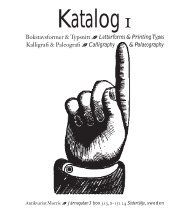[bauer - renner, paul] Steile Futura halbfett ... - Antikvariat Morris
[bauer - renner, paul] Steile Futura halbfett ... - Antikvariat Morris
[bauer - renner, paul] Steile Futura halbfett ... - Antikvariat Morris
Create successful ePaper yourself
Turn your PDF publications into a flip-book with our unique Google optimized e-Paper software.
[<strong>bauer</strong> - <strong>renner</strong>, <strong>paul</strong>] <strong>Steile</strong> <strong>Futura</strong> <strong>halbfett</strong>Bauersche Giesserei, Frankfurt am Main. No date (c.1952-53). 4to (26,8 x 19,2 cm). Sewn folder. 4 pagesshowing <strong>Steile</strong> <strong>Futura</strong> Medium in 6-48 points. 9 (all?)loose typeset ads samples in pocket at rear.”A typeface actually called ´Renner-Grotesk´ appearedin trial type castings by Stempel typefoundry in May1936. The Stempel Renner-Grotesk was very condensedin its regular weight, with a consequent stresson the modular squareness of the letters. This designseems to have been taken over by the Bauer typefoundryin 1938, and in 1939 the grotesk changed shape tosome extent, becoming less modular and incorporatingreferences to pen-made forms. The italic accompaniment to this grotesk, simply called Renner-Kursiv,was actually a true cursive, marking a decided difference between this typeface and <strong>Futura</strong>. Work onthe Grotesk and Kursiv continued through the late 1930s and early 1940s. However, progress on thesetypefaces seems to have been very slow, perhaps due to Renner´s failing health: he had a serious heartattack in 1948 (at 70 years of age) which restricted his activity. By 1951, Renner had begun to workagain, and his Grotesk began to appear in 1952 from the Bauer typefoundry under the name of <strong>Steile</strong><strong>Futura</strong>. Perhaps the typeface was renamed merely in order to link it to the successful <strong>Futura</strong> family.”Christopher Burke p. 194.The font family was released in 1952–1953. It was sold in German, English, Spanish, and French marketsas <strong>Steile</strong> <strong>Futura</strong>, Bauer Topic, Vox, Zénith respectively. SEK400 / €44[<strong>bauer</strong> - <strong>renner</strong>, <strong>paul</strong>] <strong>Steile</strong> <strong>Futura</strong>-Kursiv<strong>halbfett</strong>Bauersche Giesserei, Frankfurt am Main. No date(c. 1952-53). 4to (26,8 x 19,2 cm). Folder printedinside showing <strong>Steile</strong> <strong>Futura</strong> Italic Medium in 6-48points. 10 (all?) loose typeset ads samples, all insame size (26,5 x 19 cm). The folder worn in thefolds and with a short tear at lower part of spine.SEK400 / €44[<strong>bauer</strong> - <strong>renner</strong>, <strong>paul</strong>] <strong>Steile</strong> <strong>Futura</strong> fettBauersche Giesserei, Frankfurt am Main. Nodate (c. 1952-53). 4to (26,8 x 19,2 cm). Sewnfolder. 4 pages showing <strong>Steile</strong> <strong>Futura</strong> Mediumin 6-48 points. 11 (all?) loose typeset adssamples in pocket at rear.SEK400 / €44
gerstner, karl: kalte Kunst? zum Standort der heutigenMalereiArthur Niggli GmbH, Teufen AR 1957. Unpaginated (c. 58pages). Square 8vo (19 x 20 cm). Sewn with folding flaps.Minor stains at top left corner, top right corner bumped,otherwise a nice copy. Colour plates & b/w illustrations. 6folding plates. The rare first edition.”kalte Kunst” was Gerstner´s first authored/designed bookwhere he advocates for a specific form of rational, geometricand mathematical art, it’s a survey of the school ofconcrete-constructive abstract painting to which he belongs.Analytical commentary and diagrams with stunningprinted coloured examples from Josef Albers, Max Bill,Camille Graeser, Richard P. Lohse, Gerard Ifert, Mary Vieira and Marcel Wyss and more. A remarkableearly example of Gerstner´s ”intergral typography”. SEK975 / €107gerstner, karl & kutter, markus: Wer ist die National-Zeitung?National-Zeitung, Basel 1960. 86 pages. Square 8vo (21 x 21cm). Stiff paper wrapper. Small mark on front cover, otherwisefine. Amazing arranged b/w photos and with sectionsprinted on different coloured paper.The brochure was conceived by the advertising agencyGerstner+Kutter; it is basically a reader survey of the National-Zeitung,a Basel newspaper. The leaflet is designedby Marcel Wyss. Wyss is a Bern-based artist and graphicdesigner who is best known as the editor and designer ofSpirale, an important Swiss magazine for avant-garde artand poetry.SEK400 / €44frutiger, adrian: The Graphic Work of Adrian Frutiger / Graphismes byFrutigerMonotype House, 1964. Unpaginated (24 pages). Stapled pamphlet.Somewhat wrinkled at upper corner. Narrow 4to (27 x 14 cm). Dedicationcopy: ”Für Jerk Olof Werkmäster in freundlischer Erinnerung andas *-Seminar 1967. A Frutiger”. Illustrated examples of 44 type designsand marks plus magazines, books, engravings, sculptures. Printed at theCurwen Press.SEK400 / €44
eksell, olle: Olle Eksell DesignerOlle Eksell, 1974. Unpag. (c. 50 pages). Square 8vo (17 x 16 cm).Sewn with folding flaps. Front cover with stamped ”Mazetti-eyes”.Signed by Olle Eksell on title page. Illustrated, partly in colour,showing Eksell’s work. Text in English, German, French.Foreword by Hasan Ozbekhan. With a bibliography. Printed atBjörkmans Eftr., Stockholm.SEK350 / €39krimpen, jan van: A Perspective on Type and TypographyGallery 303, 1965. 8vo. (22 pages). Sewn, stiff paper wrappers. Limitedto 300 copies printed by The Stinehour Press to accompany a lecture byJohn Dreyfus at Gallery 303. First printed in paga vii, 1959.SEK325 / €36kindersley, david: An Essay in Optical Letter Spacing and its Mechanical ApplicationThe Wynkyn De Worde Society, London 1966 (2), 32, (2) pages. Oblong 8vo (14,8 x 21 cm). Stiff printedcard wrappers. 39 text illustrations. First Edition. Dedication copy: ”For Dick Hallström. DavidKindersley.”SEK300 / €33


![[bauer - renner, paul] Steile Futura halbfett ... - Antikvariat Morris](https://img.yumpu.com/49661110/1/500x640/bauer-renner-paul-steile-futura-halbfett-antikvariat-morris.jpg)
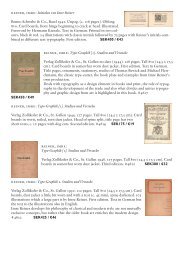
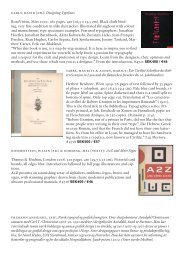
![[melin & österlin] melbi, johan (red.): John Melin ... - Antikvariat Morris](https://img.yumpu.com/37386442/1/184x260/melin-asterlin-melbi-johan-red-john-melin-antikvariat-morris.jpg?quality=85)
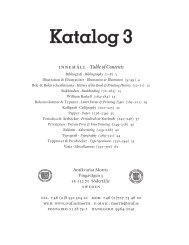
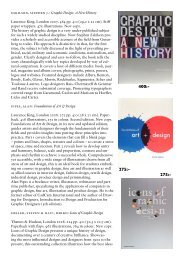
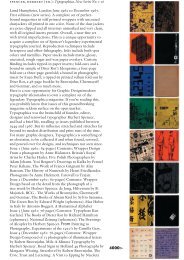
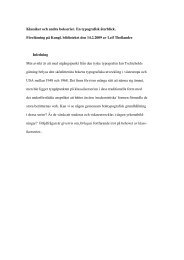
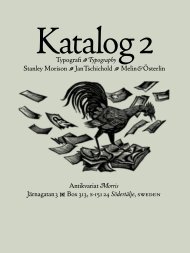
![|melin & österlin]: Olika sidor Reklam ... - Antikvariat Morris](https://img.yumpu.com/17680273/1/184x260/-melin-osterlin-olika-sidor-reklam-antikvariat-morris.jpg?quality=85)
